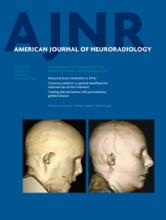Research ArticleSpine
Percutaneous Injection of Radiopaque Gelified Ethanol for the Treatment of Lumbar and Cervical Intervertebral Disk Herniations: Experience and Clinical Outcome in 80 Patients
M. Bellini, D.G. Romano, S. Leonini, I. Grazzini, C. Tabano, M. Ferrara, P. Piu, L. Monti and A. Cerase
American Journal of Neuroradiology March 2015, 36 (3) 600-605; DOI: https://doi.org/10.3174/ajnr.A4166
M. Bellini
aFrom the Neuroimaging and Neurointerventional Unit - NINT (M.B., D.G.R., S.L., M.F., L.M., A.C.)
D.G. Romano
aFrom the Neuroimaging and Neurointerventional Unit - NINT (M.B., D.G.R., S.L., M.F., L.M., A.C.)
S. Leonini
aFrom the Neuroimaging and Neurointerventional Unit - NINT (M.B., D.G.R., S.L., M.F., L.M., A.C.)
I. Grazzini
cDepartment of Medical, Surgical and Neuro Sciences, Diagnostic Imaging (I.G.), University of Siena, Siena, Italy
C. Tabano
dUnit of Radiology (C.T.), Hospital of Arzignano, Vicenza, Italy.
M. Ferrara
aFrom the Neuroimaging and Neurointerventional Unit - NINT (M.B., D.G.R., S.L., M.F., L.M., A.C.)
P. Piu
bUnit of Neurology (P.P.), Department of Neurological and Neurosensorial Sciences, Hospital “Santa Maria alle Scotte,” Siena, Italy
L. Monti
aFrom the Neuroimaging and Neurointerventional Unit - NINT (M.B., D.G.R., S.L., M.F., L.M., A.C.)
A. Cerase
aFrom the Neuroimaging and Neurointerventional Unit - NINT (M.B., D.G.R., S.L., M.F., L.M., A.C.)

This article requires a subscription to view the full text. If you have a subscription you may use the login form below to view the article. Access to this article can also be purchased.

You do not have access to the full text of this article, the first page of the PDF of this article appears above.
Log in using your username and password
In this issue
American Journal of Neuroradiology
Vol. 36, Issue 3
1 Mar 2015
Advertisement
Percutaneous Injection of Radiopaque Gelified Ethanol for the Treatment of Lumbar and Cervical Intervertebral Disk Herniations: Experience and Clinical Outcome in 80 Patients
M. Bellini, D.G. Romano, S. Leonini, I. Grazzini, C. Tabano, M. Ferrara, P. Piu, L. Monti, A. Cerase
American Journal of Neuroradiology Mar 2015, 36 (3) 600-605; DOI: 10.3174/ajnr.A4166
Percutaneous Injection of Radiopaque Gelified Ethanol for the Treatment of Lumbar and Cervical Intervertebral Disk Herniations: Experience and Clinical Outcome in 80 Patients
M. Bellini, D.G. Romano, S. Leonini, I. Grazzini, C. Tabano, M. Ferrara, P. Piu, L. Monti, A. Cerase
American Journal of Neuroradiology Mar 2015, 36 (3) 600-605; DOI: 10.3174/ajnr.A4166
Jump to section
Related Articles
- No related articles found.
Cited By...
This article has been cited by the following articles in journals that are participating in Crossref Cited-by Linking.
- Sébastien Touraine, Joël Damiano, Olivia Tran, Jean-Denis LaredoEuropean Radiology 2015 25 11
- Corrine Nief, Robert Morhard, Erika Chelales, Daniel Adrianzen Alvarez, Ioanna Bourla BS, Christopher T. Lam, Alan A. Sag, Brian T. Crouch, Jenna L. Mueller, David Katz, Mark W. Dewhirst, Jeffrey I. Everitt, Nirmala Ramanujam, Feng ZhangPLOS ONE 2021 16 1
- Stefano Marcia, Matteo Bellini, Joshua A. Hirsch, Ronil V. Chandra, Emanuele Piras, Mariangela Marras, Anna Maria Sanna, Luca SabaEuropean Journal of Radiology 2018 109
- Matteo Bellini, Marco Ferrara, Irene Grazzini, Alfonso CeraseMagnetic Resonance Imaging Clinics of North America 2016 24 3
- Karishma Patel Bhangare, Alan D. Kaye, Nebojsa Nick Knezevic, Kenneth D. Candido, Richard D. UrmanAnesthesiology Clinics 2017 35 2
- Karlo Houra, Darko Perovic, Ivan Rados, Drazen KvesicPain Medicine 2018 19 8
- Masoud Hashemi, Payman Dadkhah, Mehrdad Taheri, Pegah Katibeh, Saman AsadiThe Korean Journal of Pain 2020 33 1
- Stefano Marcia, Chiara Zini, Matteo BelliniNeuroimaging Clinics of North America 2019 29 4
- K. Latka, K. Kozlowska, M. Waligora, W. Kolodziej, D. LatkaClinical Radiology 2023 78 12
- Domenico La Torre, Giorgio Volpentesta, Carmelino Stroscio, Caterina Bombardieri, Domenico Chirchiglia, Giusy Guzzi, Dorotea Pugliese, Emilio De Bartolo, Angelo LavanoBritish Journal of Pain 2021 15 2
More in this TOC Section
Similar Articles
Advertisement






